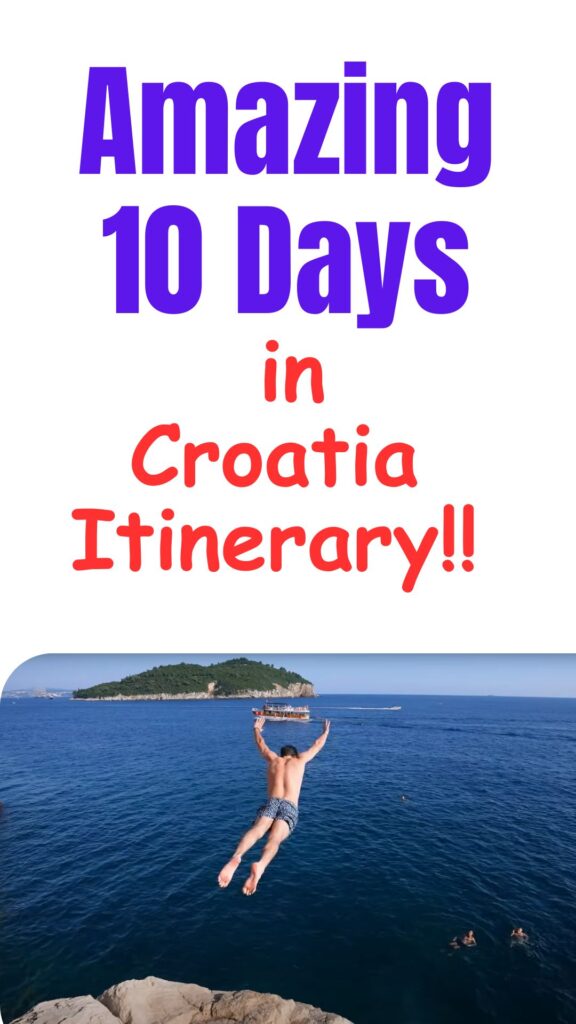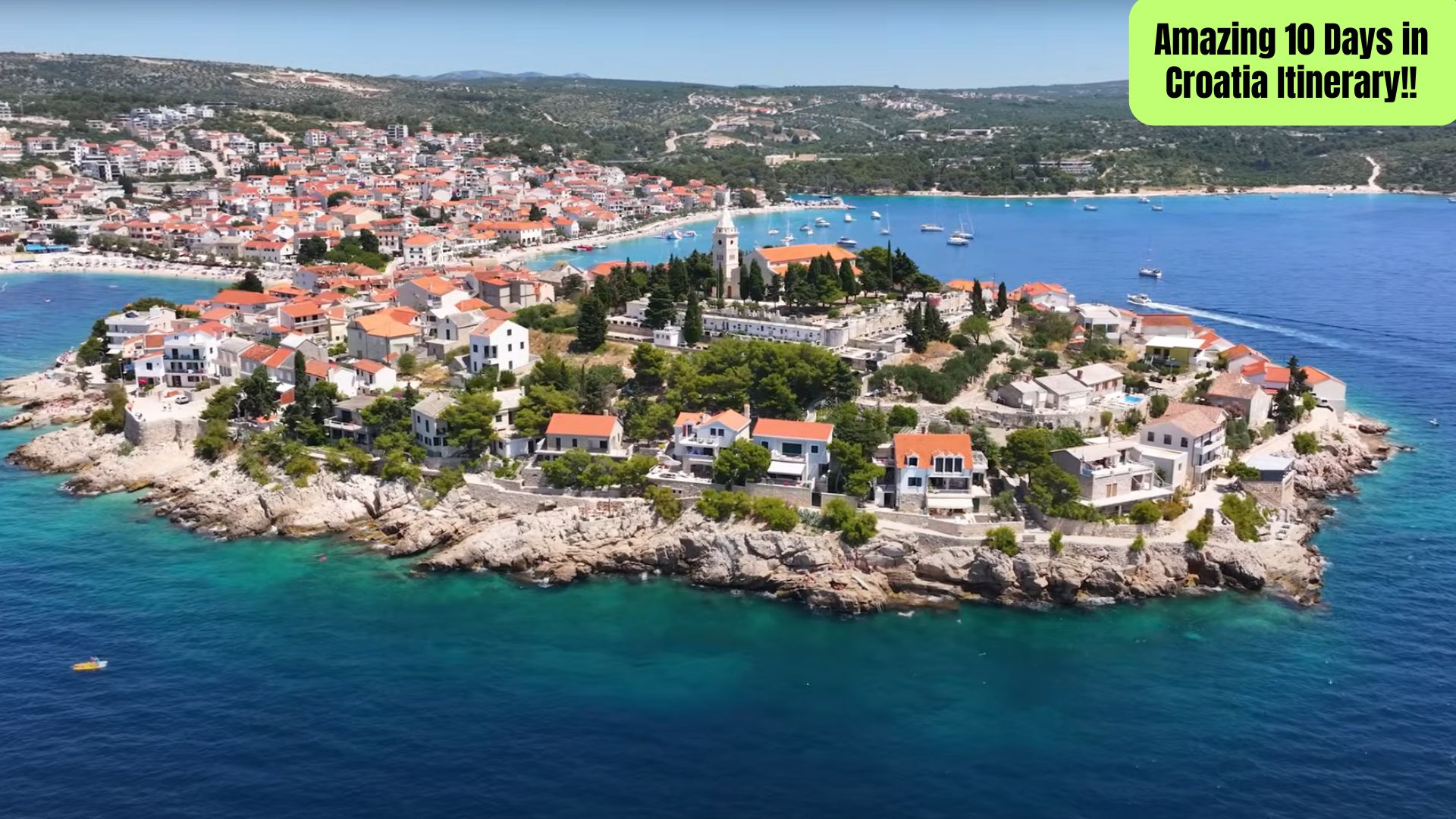Have you ever dreamed of swimming in crystal-clear waters, walking through centuries-old cities, and watching sunsets that genuinely stop you in your tracks? That’s exactly what Croatia offers. I spent 10 days there recently, and it was one of the most effortlessly beautiful and enriching trips I’ve taken. If you’re planning a European adventure, this 10 Days in Croatia Itinerary hits all the right notes—from relaxed beach towns to buzzing city life and jaw-dropping national parks.
Croatia is compact, which makes it easy to explore without feeling rushed. You can start up north and work your way down the Adriatic coast—or do the reverse, depending on your flight options. Either way, you’ll get a great mix of culture, food, history, and nature.
Trip At a Glance
- Day 1-2: Zagreb – The quirky and cozy capital
- Day 3: Plitvice Lakes – Waterfalls that seem too perfect to be real
- Day 4-5: Zadar & Šibenik – Roman ruins, sea organs, and medieval charm
- Day 6-7: Split – Roman palaces and buzzing nightlife
- Day 8-9: Hvar or Korčula – Island hopping and beach bliss
- Day 10: Dubrovnik – The grand finale inside ancient city walls
Travel Tips Before You Go
- Best time to visit: May to early October. July and August are peak (and hot), but perfect for beach days.
- Getting around: Buses are reliable and cheap. Ferries connect the islands. Renting a car gives you the most flexibility, especially for Plitvice.
- Currency: Croatia uses the Euro (€), but card payments are common.
- Language: Croatian is the official language, but English is widely spoken, especially in tourist areas.
- Packing tip: Bring swim gear, comfortable shoes, and layers—northern Croatia can be cooler than the coast.
Let’s dive into the day-by-day plan so you can make the most of your amazing 10 days in Croatia.
Day 1–2 – Zagreb: Croatia’s Cool and Understated Capital
When you think of Croatia, your mind might jump straight to the coastline—but don’t skip Zagreb. It’s quirky, laid-back, and full of personality. I landed here and immediately loved its café culture, cobbled streets, and oddball museums.

What to Do in Zagreb
- Wander the Upper Town (Gornji Grad):
This part of Zagreb is like stepping into a storybook. Think pastel-colored houses, quiet streets, and stunning views. Don’t miss St. Mark’s Church with its colorful tiled roof—it’s even prettier in person. - Ride the World’s Shortest Funicular:
Just 66 meters long, this funicular connects the Upper and Lower Towns. It’s a quick ride, but fun and worth doing just for the novelty. - Visit the Museum of Broken Relationships:
Sounds strange? It is—and it’s brilliant. This museum showcases items donated by people from all over the world, each with a story of heartbreak or hope. It’s funny, sad, and surprisingly moving. - Relax in Zrinjevac Park:
This green space in the heart of the city is perfect for an afternoon break. Grab a coffee and do some people-watching—it’s a favorite local pastime.
Where to Eat in Zagreb
- La Štruk:
Try the house specialty, štrukli—a baked pastry dish filled with soft cheese. You can get it sweet or savory, and it’s as comforting as it sounds. - Dolac Market:
A must-see. This open-air market is full of fresh produce, cheeses, and local specialties. It’s a great place to snack or grab picnic supplies.
Where to Stay
- Budget: Chillout Hostel – central, social, and surprisingly quiet at night.
- Mid-range: Hotel Jägerhorn – charming and right near the main square.
- Splurge: Esplanade Zagreb Hotel – classic luxury, just steps from the train station.
Zagreb is often skipped, but spending your first two days here sets a lovely pace for the rest of your trip. It’s a city that invites you to slow down and soak it in.
Next stop: the magical waterfalls of Plitvice Lakes—Day 3!
Day 3 – Plitvice Lakes: Nature’s Watercolor Painting
This was easily one of the most surreal days of the trip. Imagine 16 turquoise lakes flowing into each other through a series of waterfalls—some big, some small, all stunning. That’s Plitvice Lakes National Park, and it’s a UNESCO World Heritage site for good reason.
Planning Your Visit
- Getting There:
From Zagreb, it’s about a 2-hour drive. You can rent a car or take a direct bus. If you’re not keen on public transport, a day tour is also a good option. - Best Routes Inside the Park:
The park is split into the Upper Lakes and Lower Lakes, and there are several looped trails (A through K). I chose Route C, which takes about 4–5 hours. It gives you a full picture of both sections, including a scenic electric boat ride and shuttle. - When to Go:
Arrive early—like 8 AM early—especially in peak season. The park fills up quickly and loses some of its magic when crowded.
What Makes It Special
There are countless waterfalls here, but the big one—Veliki Slap (The Great Waterfall)—is a jaw-dropper. The wooden boardwalks let you walk right over the water, sometimes with fish swimming beneath your feet.
The water really is that unreal shade of blue-green. No filters needed.
What to Eat Nearby
Food options inside the park are limited and overpriced. I packed snacks and water. If you’re driving, stop at Lička Kuća, just outside the park—authentic local dishes like roasted lamb or trout, served in a cozy, wooden tavern atmosphere.
Where to Stay
If you want to beat the morning crowds, consider staying overnight nearby.
- Budget: Guesthouse Sven – simple, clean, and 10 minutes from the entrance.
- Mid-range: Villa Lika – a stylish B&B with homemade breakfast.
- Splurge: Ethno Houses Plitvica Selo – luxury meets tradition in a rustic setting.
By the end of the day, your legs might be tired, but your camera roll will be glowing. Trust me, Plitvice is one of those places that leaves a mark.
Next: Day 4–5 – Coastal gems Zadar & Šibenik
Days 4–5 – Zadar & Šibenik: Roman Echoes and Coastal Calm
After a day in nature, it was time to head toward the coast—and wow, was it worth it. Zadar and Šibenik are two often-overlooked gems, full of old-world charm, sea views, and chill vibes. I split these two days between exploring Roman ruins, eating my weight in seafood, and watching one of the most unforgettable sunsets I’ve ever seen.
Day 4 – Zadar: History Meets Modern Art
Zadar feels like a calm cousin of Split or Dubrovnik. It’s full of Roman and Venetian ruins, but what really blew me away were its modern sea installations.
- Don’t Miss:
- Sea Organ:
It plays music from the waves. I sat here for an hour just listening and watching the boats go by. - Greeting to the Sun:
Next to the Sea Organ, this solar-powered circle lights up at night. It’s like watching the northern lights on the pavement. - Roman Forum & St. Donatus Church:
A peaceful square where kids play among 2,000-year-old ruins. Casual, right?
- Sea Organ:
- What to Eat:
- Try the black risotto (crni rižot) at Restaurant Bruschetta—delicious and right by the sea.
- Grab ice cream from Sladoled Kod Djure, a local favorite.
- Try the black risotto (crni rižot) at Restaurant Bruschetta—delicious and right by the sea.
Day 5 – Šibenik: Medieval Magic Without the Crowds
Šibenik is only about an hour from Zadar by bus or car, and I highly recommend not skipping it. It’s quieter than other coastal towns, but full of beauty and soul.
- Top Sights:
- St. James’ Cathedral:
A UNESCO World Heritage Site built entirely of stone—no mortar! Look out for the 71 faces carved into its exterior. - St. Michael’s Fortress:
Offers panoramic views over the terracotta rooftops and the sea. In summer, they even host concerts here.
- St. James’ Cathedral:
- Bonus Tip:
If you’re into waterfalls and skipped Plitvice, Krka National Park is just a 20-minute drive away. You can swim near some of the falls (unlike Plitvice), which is perfect on a hot day.
Getting Around
Buses run regularly between Zadar and Šibenik, but I found having a rental car here super convenient—especially if you’re doing Krka as a side trip.
Zadar felt like a place to relax and reflect. Šibenik was where I truly felt like I stumbled onto something secret and special. After two days here, I was ready for the buzz of the Dalmatian coast.
Next up: Days 6–7 in Split—the heart of coastal Croatia!
Days 6–10 – Split, the Islands & Dubrovnik: The Coastal Finale
This is where the trip shifts gears—from medieval towns and waterfalls to sun-drenched beaches, Roman ruins, and the Game of Thrones-style drama of Dubrovnik. Days 6 to 10 were a blur of beauty, ferry rides, and late-night gelato strolls.
Days 6–7 – Split: Roman Ruins & Seaside Energy
Split is alive. It’s the kind of city where the past and present tangle in the best way. At the heart of it all is Diocletian’s Palace, a 1,700-year-old Roman complex that’s now full of shops, cafes, and apartments.
- What to See:
- Diocletian’s Palace:
Wander freely through its cellars, courtyards, and narrow alleys. It’s not a museum—it’s the city center! - Climb the Bell Tower of St. Domnius:
The steps are narrow, but the view? Worth every breath. - Riva Promenade:
Grab a drink and watch the boats come and go. It’s the place to be in the evening.
- Diocletian’s Palace:
- Where to Eat:
- Bokeria Kitchen & Wine Bar: For modern Dalmatian fare in a beautiful setting.
- Fife: Budget-friendly, big portions, and a local favorite.
- Bokeria Kitchen & Wine Bar: For modern Dalmatian fare in a beautiful setting.
- Side Trip Option:
- Take a half-day boat tour to the Blue Lagoon for snorkeling in electric-blue waters.
- Take a half-day boat tour to the Blue Lagoon for snorkeling in electric-blue waters.
Days 8–9 – Island Time: Hvar or Korčula
Island-hopping is a must. I chose Hvar for the beaches and buzz, but Korčula is a fantastic alternative if you prefer a slower, more relaxed pace.
- Getting There:
Ferries run daily from Split. Book in advance during summer. - Hvar Highlights:
- Hvar Town: Chic, historic, and full of nightlife.
- Pakleni Islands: Rent a boat or take a water taxi to reach these laid-back slices of paradise.
- Climb to Fortica Fortress: Sunset here is chef’s kiss.
- Hvar Town: Chic, historic, and full of nightlife.
- Korčula Highlights:
- Often called “Little Dubrovnik” for its walled old town.
- Said to be the birthplace of Marco Polo (check out the tiny museum).
- Quieter, cheaper, and ideal for wine lovers—don’t miss a glass of Grk wine.
- Often called “Little Dubrovnik” for its walled old town.
- Where to Stay:
- Hvar: Pharos Hvar Bayhill Hotel – trendy and affordable.
- Korčula: Tara’s Lodge – peaceful, beachfront, and beautifully designed.
- Hvar: Pharos Hvar Bayhill Hotel – trendy and affordable.
Day 10 – Dubrovnik: The Grand Finale
Ending in Dubrovnik felt poetic. The old town, encased in massive stone walls, is impossibly scenic and full of history. Yes, it’s popular—but for good reason.
- What to Do:
- Walk the City Walls:
It takes about 2 hours. Go early or late to avoid the heat and crowds. - Take the Cable Car:
For a sweeping view of the Adriatic from Mount Srđ. - Explore Lokrum Island:
Just a short ferry ride from Dubrovnik, this nature reserve has peacocks, ruins, and cliffside swimming spots.
- Walk the City Walls:
- Where to Eat:
- Lady Pi-Pi: BBQ with a view—go early, there’s no reservation system.
- Taj Mahal (not Indian!): A cozy Bosnian spot with hearty, delicious dishes.
- Lady Pi-Pi: BBQ with a view—go early, there’s no reservation system.
- Final Tips:
- Dubrovnik is more expensive, so budget accordingly.
- It’s small—one day is enough unless you want to linger or do more island trips.
- Dubrovnik is more expensive, so budget accordingly.
Final Thoughts
This 10-day journey through Croatia gave me the best of all travel worlds: calm nature, ancient history, great food, and seaside fun. From the underrated charm of Zagreb to the cinematic beauty of Dubrovnik, every stop had something that made me pause and smile.
Croatia doesn’t scream for attention—it doesn’t need to. It simply invites you in, and before you know it, you’re already planning your return.
Keyword Recap: 10 Days in Croatia Itinerary, Croatia travel tips, where to go in Croatia, Croatia itinerary for first-timers, Zagreb to Dubrovnik route


